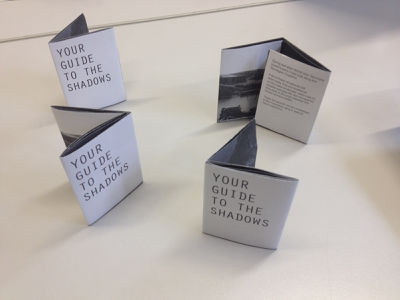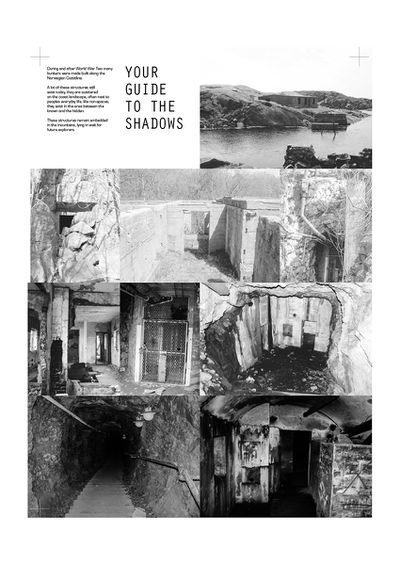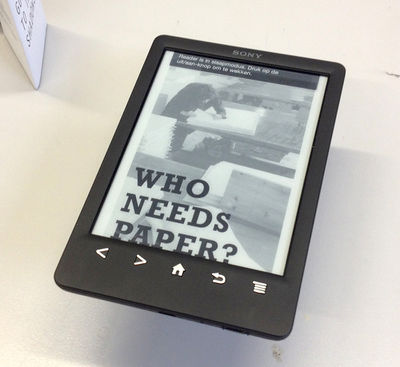User:ThomasW/thomas photobook: Difference between revisions
No edit summary |
No edit summary |
||
| (7 intermediate revisions by the same user not shown) | |||
| Line 8: | Line 8: | ||
True the experience of the book you dive deep into a mountain, but you can never truly know how it looks without going to this places yourself, as experience is something you need never can show with images alone. | True the experience of the book you dive deep into a mountain, but you can never truly know how it looks without going to this places yourself, as experience is something you need never can show with images alone. | ||
It | It did take the form of small maps that you can find on any public-transport or tourist information points in big cities. | ||
All of the photos taken by myself | |||
[[File: | [[File:PhotobookShadowsFront.jpg|400px]] | ||
[[File: | [[File:PhotobookShadowsBackside.jpg|400px]] | ||
=== Digital Photobook === | === Digital Photobook === | ||
The death of printed have been predicted since the beginning of the 1900s from the invention of the telegraph, microfilm and later years with the invention of computers and the internet. | |||
[[Digitaleinkphotobook.jpg|400px]] | Paper is still being used for print and even with the increased usage of the computers and the internet. Since the start of the computer age, it have been said we are getting a ‘paperless office’. | ||
The ‘paperless office’ have yet to materialism, the term was first used in the article “The Office of the Future”, published in Business Week in June 1975. The second section of the article is titled “The Paperless Office”. The section did look into electronic methods of managing information which were expected to reduce, progressively but drastically, the amount of paper used in the working environment. | |||
---- | |||
''Xerox was becoming alarmed at the idea of the ‘paperless office’, the revolution in business life that computers were, apparently,about to bring about. To meet this challenge Xerox decided to become part of the computer revolution itself. To this end it set up Xerox PARC on the West Coast of the United States." (Gere, 2002, Page 134) Gere, Charlie (2002) Digital Culture, London, Reaktion Books'' | |||
---- | |||
Paper is still used in the every-day life but the manufacturing have gone down or been exported to low cost country’s. The result is that there are a lot of paper-mills being shut down all over the world. | |||
Is the shutdown from lowering of demand for paper or outsourcing to “low-cost” country’s with lower concerns for environmental and working conditions. | |||
[[File:Digitaleinkphotobook.jpg|400px]] | |||
[https://vimeo.com/123546898 PLAY VIDEO] | [https://vimeo.com/123546898 PLAY VIDEO] | ||
Some of the photos taken by myself, some from [http://hist.hunsfos.no archives] Some photos from past and present match up after looking at physical features of the factory like windows, columns. | |||
=== Inspiration === | === Inspiration === | ||
*[https://www.youtube.com/watch?v=P8mxT8eprVM Ed van der Elsken Natlab Philips Company Photography] | *[https://www.youtube.com/watch?v=P8mxT8eprVM Ed van der Elsken Natlab Philips Company Photography] | ||
*[http://www.wired.com/2015/03/marc-wilson-the-last-stand-wwii/ The Ghostly WWII Ruins of Europe’s Northern Coasts] | *[http://www.wired.com/2015/03/marc-wilson-the-last-stand-wwii/ The Ghostly WWII Ruins of Europe’s Northern Coasts] | ||
*[https://vimeo.com/50512991 Mushrooms of Concrete] | |||
*LINK 4 | |||
*LINK 5 | |||
*LINK 6 | |||
Latest revision as of 14:55, 4 April 2015
Printed Photobook
I have always been fascinated with abandon building and place. The exist close to everyday life but outside people perception. To maybe get some people to take a interest in this places I wanted to make a "photo-book" that shows places of interest but never shows you the whole pictures.
True the experience of the book you dive deep into a mountain, but you can never truly know how it looks without going to this places yourself, as experience is something you need never can show with images alone.
It did take the form of small maps that you can find on any public-transport or tourist information points in big cities. All of the photos taken by myself
Digital Photobook
The death of printed have been predicted since the beginning of the 1900s from the invention of the telegraph, microfilm and later years with the invention of computers and the internet.
Paper is still being used for print and even with the increased usage of the computers and the internet. Since the start of the computer age, it have been said we are getting a ‘paperless office’.
The ‘paperless office’ have yet to materialism, the term was first used in the article “The Office of the Future”, published in Business Week in June 1975. The second section of the article is titled “The Paperless Office”. The section did look into electronic methods of managing information which were expected to reduce, progressively but drastically, the amount of paper used in the working environment.
Xerox was becoming alarmed at the idea of the ‘paperless office’, the revolution in business life that computers were, apparently,about to bring about. To meet this challenge Xerox decided to become part of the computer revolution itself. To this end it set up Xerox PARC on the West Coast of the United States." (Gere, 2002, Page 134) Gere, Charlie (2002) Digital Culture, London, Reaktion Books
Paper is still used in the every-day life but the manufacturing have gone down or been exported to low cost country’s. The result is that there are a lot of paper-mills being shut down all over the world.
Is the shutdown from lowering of demand for paper or outsourcing to “low-cost” country’s with lower concerns for environmental and working conditions.
Some of the photos taken by myself, some from archives Some photos from past and present match up after looking at physical features of the factory like windows, columns.




